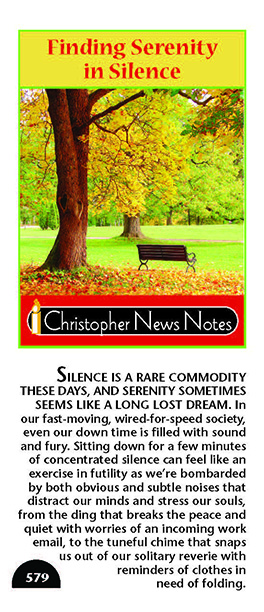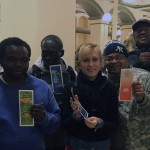 The following is the text of the Christopher News Note “Finding Serenity in Silence” (which was written by a freelancer). If you’d like a pdf or hard copy, see the end of this post:
The following is the text of the Christopher News Note “Finding Serenity in Silence” (which was written by a freelancer). If you’d like a pdf or hard copy, see the end of this post:
Silence is a rare commodity these days, and serenity sometimes seems like a long lost dream. In our fast-moving, wired-for-speed society, even our down time is filled with sound and fury. Sitting down for a few minutes of concentrated silence can feel like an exercise in futility as we’re bombarded by both obvious and subtle noises that distract our minds and stress our souls, from the ding that breaks the peace and quiet with worries of an incoming work email, to the tuneful chime that snaps us out of our solitary reverie with reminders of clothes in need of folding.
In some ways, it seems like a losing battle. It’s tempting to think that it would be easier to simply accept the constant buzz and whir as the new status quo. But when we do that, we risk drowning out the still small voices inside that call us to prayer, creativity, solitude, and, ultimately, serenity.
If our goal is to find serenity through silence, it helps if we start by defining “serenity.” What exactly are we seeking through those quiet moments when we listen for the whisper of the Spirit? In the first part of a prayer written by Reinhold Niebuhr and popularized by Alcoholics Anonymous, we pray: “Lord, grant me the serenity to accept the things I cannot change, courage to change the things I can, and wisdom to know the difference.”
So serenity is an interior attitude, a space where we are not shaken by problems and fears, where we navigate the ups and downs of our lives knowing that things are unfolding as they should. So how do we get there? In silence.
Beneath the Chaos of Daily Life
Saints and sages, medical experts and business leaders, spiritual teachers and self-help gurus alike all agree that even a few minutes of dedicated silence on a regular basis can transform our day, our life, and our eternity. Face to face with God in the quiet, we begin to hear the low-but-constant drumbeat of our long-overlooked spiritual selves.
Father Jonathan Morris, in his book “The Way of Serenity,” talks about the fact that if we go through life like a hamster furiously spinning on its wheel, we will never move forward or have the opportunity to live fully.
“We are called to something higher. We are called to reflect, to contemplate, to examine, to explore, and to consider,” he writes. “Yet nowadays we always seem to have something more important to do than simply to think about our lives—where we are going, how we are living, what sort of people we are trying to be.”
Father Morris explains that we “cannot find ourselves outside ourselves,” and we cannot find wisdom outside of God. And both of those important elements require us to carve out some silent time away from the hamster wheel of daily life. “It is in interior silence and friendship with God that wisdom flourishes, for the closer we are to God the more easily we discern His plan for our lives,” he says.
When we are finally able to figure out what God’s plan for our life might be or, conversely, stop trying to figure it out at all, we begin to feel the stirrings of real serenity and joy, the kind of happiness that until that point may have seemed elusive, even impossible, but was, in fact, always present. It was simply hidden beneath the chaos of daily life.
Placing Ourselves in the Silence
“Serenity is the fruit of silence. I don’t see how serenity can arise out of any experience other than silence…When the wordless experience of God’s grace enters us—or better, arises within us, or suddenly embraces us — we have tasted serenity, and eternity,” says Ken Giovanelli, director of pastoral care at a Pennsylvania retirement community who has long practiced deep silent prayer. “But, as (Thomas) Merton would say, as soon as we have sensed God has arrived, God has already passed. First, find silence—the silence of Christ in God— and then serenity may be given to you. Serenity is not ‘embedded’ somewhere in the silence; it is God’s gracious gift to you.”
Giovanelli stresses that in the Christian practice of silent prayer, we do not seek emptiness or detachment, as might be the case in other spiritual traditions, but rather just the opposite. We seek the “silence and eternity of God.”
Of course, that’s not necessarily easy. Anyone who has ever sat down to silent prayer knows how quickly “monkey mind” sets in, those interior voices that remind us of every last thing we have to do, from the ridiculous to the sublime, whether we are obsessing over that night’s dinner menu or confronting the personal demons that haunt the recesses of our minds. Silence and, by extension, serenity take practice — prayer practice.
“True silence is beyond ego. Be silent. Do not think: ‘preserve the silence.’ Think: ‘silence preserves me.’ Keeping that in mind helps me to remember that when I enter into silent prayer, when I enter into my heart, I must let go and not strive for anything, even the idea that ‘I am entering into silence, into prayer.’ I must let go of my mind—words and thoughts—and enter the deep heart where the silence of God is always ‘preserving me,’” Giovanelli explains.
Ego’s Weeds, Compassion’s Seeds
Anne LeClaire turned the idea of regular quiet prayer into days of silence on the first and second Monday of every month. It proved to be a challenge for herself and her family and friends. When she first began, her husband questioned why she needed to do it at all and what he should do if someone called for her or if he needed to ask her a question. But she knew that occasional silence was no longer a luxury for her; it had to be.
“As the months and years passed, I rediscovered that silence was not a product but a process, one that often pulled me from mindless behavior and offered opportunities for transformation. In fact, each silent Monday continued to bring a new teaching, a fresh crop of understanding,” LeClair writes in “Listening Below the Noise: A Meditation on the Practice of Silence.”
She woke up one morning feeling angry toward her husband, despite the fact that she had no idea why. Then she remembered that he’d said something to upset her on their drive to the beach the day before, which happened to be one of her silent days. Try as she might, she could not dredge up even a fragment of what had quietly enraged her on the road just one day earlier. Then came an Aha! moment.
“What if it hadn’t been a silent day? If I had been speaking during our drive, where would our discussion have led? And to what purpose?…When we are truly silent—within and without—we surrender the ego’s need to be right…Too often we would rather be right than be happy. Or even content,” she says.
Silence replaces the weeds of ego with the seeds of compassion, the need to win with the desire to love, and therein lies the road to serenity. Of course, few of us would have the time or motivation to take two entire days of silence each month, but could we take one day a month? A half day? Is it possible to carve out a sliver of silence on a regular basis and learn bit by bit to prefer being happy over being right?
Father John Michael Talbot – composer, author and founder of the Brothers and Sisters of Charity at Little Portion Hermitage in Arkansas – writes often about the challenge of silence, solitude and serenity amid the chaos and noise of our frenetic world.
Acknowledging that most people are not called to lives of solitude in a monastery or hermitage, he stresses that it is still critical to carve out both time and space for daily silence if we want to reach that place of interior stillness and exterior serenity:
“The way of stillness is based upon the example of Christ himself. Jesus first went to the desert to prepare for His ministry. He went to the place of the greatest stillness to prepare for the ultimate action. He went to the place of deafening silence to hear the most profound word,” Father Talbot writes in “The World Is My Cloister: Living from the Hermit Within.”
And while solitude and silence lead eventually to stillness and serenity, we have to be prepared for what silence may first stir up in us, he says, comparing our silence to the still pond that is suddenly agitated by a breeze that makes the waters muddy and unclear.
“It is only when the waters settle that they become calm and we can see our true image in them. Then we can reflect all life around us and glimpse the very image of God…If we are patientand sincere, God will find us.”
Silence Leads to Authentic Relationships
In allowing ourselves to be found by God in the silence, we open the door to true serenity. Pope Benedict XVI, writing for World Communications Day in 2012, said it is often in silence that the most “authentic” communication occurs.“Silence is an integral element of communication; in its absence, words rich in content cannot exist. In silence, we are better able to listen to and understand ourselves; ideas come to birth and acquire depth; we understand with greater clarity what it is we want to say and what we expect from others; and we choose how to express ourselves,” the pope emeritus wrote. “By remaining silent we allow the other person to speak, to express him or herself; and we avoid being tied simply to our own words and ideas without them being adequately tested. In this way, space is created for mutual listening, and deeper human relationships become possible…If God speaks to us even in silence, we in turn discover in silence the possibility of speaking with God and about God.”
To receive a pdf or mailed copy of “Finding Serenity in Silence” – or to subscribe to Christopher News Notes via email or snail mail – send your request to [email protected]












